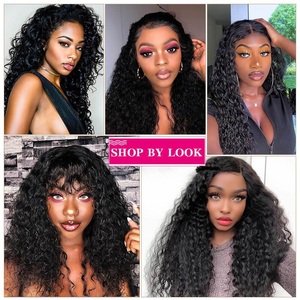
All categories
Featured selections
Trade Assurance
Buyer Central
Help Center
Get the app
Become a supplier

(8588 products available)





















































Market Size: The global synthetic wigs market is witnessing substantial growth, with the U.S. hair wigs and extensions market valued at USD 2.79 billion in 2023 and projected to grow at a remarkable CAGR of 14.69% from 2023 to 2029. This growth is largely driven by increased participation in themed events like Halloween, along with rising consumer interest in versatile hairstyles facilitated by technological advancements in wig production.
Consumer Insights: The demand for synthetic wigs is prominent among both men and women, particularly those seeking affordable and low-maintenance styling options. Key purchasing drivers include the desire for natural-looking hair, customization possibilities, and the burgeoning trend of wigs as fashion accessories. Moreover, a significant unmet need exists for wigs that cater to specific demographics, such as cancer patients experiencing hair loss due to treatment, highlighting the importance of comfort and realism in product offerings.
Top Brands Dynamics and Innovators: Leading companies in the synthetic wigs market are actively innovating to meet consumer demands. For instance, in recent product launches, brands like Jon Renau and UniWigs have introduced advanced materials that enhance the natural appearance and comfort of synthetic wigs. As the market evolves, brands are increasingly focusing on personalization and quality, ensuring that their offerings resonate with the growing expectations of consumers for both aesthetic appeal and functionality.
There are various kinds of synthetic wigs, depending on the materials used to make them. Some of the more common types include:
Each type of synthetic wig has its unique features and benefits, catering to different preferences and requirements in terms of comfort, style, and budget.
Wholesale synthetic wigs buyers have various options to choose from. Here are some factors they should consider when choosing a synthetic wig factory.
Reputation
Check the factory's reputation. Read reviews on the factory's website. Look for reviews on third-party websites. Check the factory's rating on those websites. Read the comments to see what customers like or dislike about the factory. The reviews can give buyers an idea of the quality of the factory's products and its customer service. Choose a factory with a good reputation and high ratings.
Quality
Check the quality of the products the factory sells. After all, the goal is to satisfy end customers with quality wigs. Ask the factory to provide samples. Examine the sample carefully. Check the stitching, cap construction, and natural look. The synthetic wig should be comfortable and have a natural look.
Customization
Some synthetic wig factories offer custom solutions. This may be helpful for businesses that want to sell unique wigs to their customers. Choose a factory that allows buyers to select the material, color, style, and quantity. Some factories may allow customers to add their logos to the wig.
Production capacity
Consider the factory's production capacity. Choose a factory that can produce enough wigs to meet the business's needs. Check how long it takes the factory to produce the wigs. This production time may be important when ordering seasonal wigs.
Customer service
Consider the factory's customer service. Choose a factory that responds quickly to messages. The wigs buyers may need to ask the factory various questions. The factory staff should be polite and willing to help customers. Check the factory's communication skills. Choose a factory with excellent communication skills. The staff can provide helpful information that can assist buyers in making decisions.
Location
Check the factory's location. Choosing a factory in the same country as the customers can improve communication. The factory staff can understand the local customers' needs and market trends. Also, the delivery time will be shorter when the factory is close to the customers.
Installing a synthetic wig is a straightforward process. Here are the steps to install it:
When using synthetic wigs, it is essential to follow specific safety precautions to avoid damage:
Hair Replacement:
Wigs can be used to cover hair loss due to health conditions, surgeries, or medical treatments. They offer an easy solution to hair loss without solving the underlying cause.
Fashion and Beauty:
Different styles, colors, and textures of wigs let people experiment with their looks and self-expression. Wigs let one try out different kinds of looks for fun, without any permanent changes to one's real hair.
Protection:
Wigs can be worn to protect natural hair from harsh environmental conditions, chemicals, or heat styling. They allow the natural hair to rest and recover while still looking stylish.
Lightweight Construction:
Lightweight materials are used to make wigs so they are comfortable to wear for long periods without feeling heavy or burdensome on the head.
Breathable Cap Designs:
Wigs have caps that allow air to circulate, preventing heat and sweat buildup from causing discomfort or irritation to the scalp.
Adjustable Fit:
Wigs come with adjustable straps inside the cap so the wearer can customize the fit according to head size and shape for security and comfort.
Natural-Looking Hairline:
Wigs are designed with a realistic hairline and parting options so they look authentic and blend well with natural hair or skin tone.
Versatile Styling Options:
Wigs can be styled in many ways, such as curling, straightening, or changing the direction of the bangs. This allows one to change their look whenever they want.
Cap Construction:
Wigs have different cap contraptions, like open wefted for maximum airflow or lace for a realistic hairline.
Hair Distribution:
Wigs have hair evenly distributed throughout the cap for a natural look or concentrated at the crown for added volume and lift.
Hair Texture:
Wigs come in many hair textures, such as straight, wavy, and curly, to match or complement one's natural hair texture and style preferences.
Color Matching:
Wigs are available in different shades, highlights, and lowlights to mimic or enhance one's hair color and skin tone.
Length and Layering:
Wigs come in many lengths from short bobs to long flowing locks, with different layering techniques to frame the face and flatter features.
Q1: Can wigs from a synthetic wig factory be customized?
A1: Yes. Many factories offer customized options for their synthetic wigs. Businesses can order wigs tailored to meet the specific needs of their customers. This includes selecting the wig's color, style, and size. Some factories may also offer the option to customize the packaging.
Q2: What are the typical minimum order quantities (MOQs) for synthetic wigs?
A2: The MOQs vary from one factory to another. They may offer synthetic wigs with an MOQ of 50 pieces. Other factories may have an MOQ of 1000 pieces. It all depends on the factory's production capacity and the type of synthetic wig.
Q3: What trends are currently affecting the synthetic wig market?
A3: Some of the trends affecting this market include an increased demand for natural-looking synthetic wigs and those with lace fronts. Other trends include an increased demand for sustainable wigs made from eco-friendly materials and wigs that come in various colors and styles.
Q4: How should synthetic wigs be stored?
A4: The synthetic wigs should be detangled before storage. Then, they should be washed and dried. The wig should be placed on a wig stand or in its original packaging. It should be stored in a cool, dry place away from direct sunlight. This storage method will ensure the wig maintains its shape and quality for a long time.